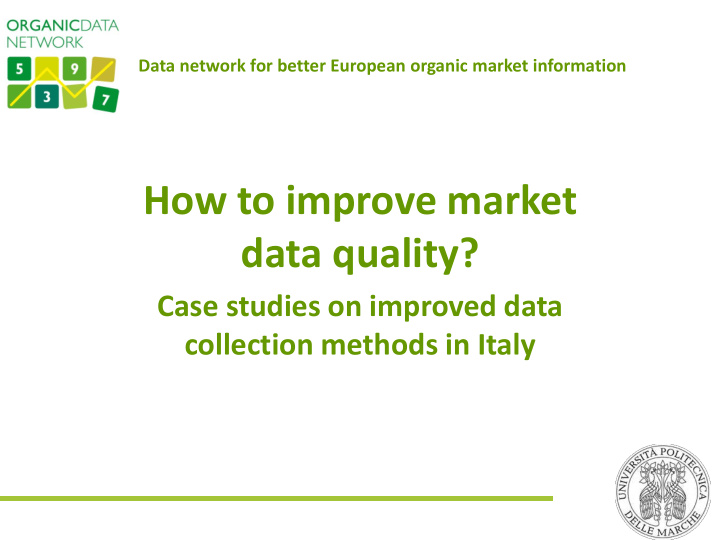



Data network for better European organic market information How to improve market data quality? Case studies on improved data collection methods in Italy
IT organic data collection system /Background The analysis was conducted during two workshops (6th of May and 18th of June 2013) and involved the national bodies that currently collect and publish data: MIPAAF, SINAB,ISMEA, IAMB, ASSOBIO. Three main issues: 1. International trade data 2. Production volume and value 3. Domestic trade/market data
Current data and gaps/1 1. International trade data (Import) Import data for organic products is currently collected and published by SINAB on the basis of: import authorizations issued by the Ministry: not under the equivalence regime ( 38 % of the total products imported in 2012; expected to decrease, since member states shall no longer grant any authorization from July 2014 ). self declarations issued by the importers: both equivalence and not equivalence regime (MIPAAF recently set up a Ministerial decree - Nr. 18378 of 9 August 2012) Could be not fully reliable Need for consistency check/cross check with other dataset. 3
Areas of improvement/1 1. Import data cross checking potential volume authorized to be Import authorization: imported, by organic products not equivalence regime Progress of work/1: integration & FINAL 1 st step • 1° step completed = MIPAAF database finalized consistency check database on import Self-declaretion exact volume imported by organic equivalence/not products equivalence regime • Next Step = cross check 2 nd step MIPAAF database vs CUSTOMS database integration & consistency check Data from customs : exact volume imported by organic Equivalence / not products . Using the code C644 in equivalence regime box 44. 4
Current data and gaps/2 2. Production volume and value data A t present there are no “official” data collected for what concern volume (in tons) and value (in million Euros) of organic primary production (for both crops and livestock). A rough estimation was recently conducted by SINAB Info are based on the potential production Consistency check carried out for the declared from the farmers in OrganicDataNetwork SURVEY the annual production plan……. highlighted the need for further study! 5
Areas of improvement/2 2 Production volume and value Volume i 1 2 3 Annually collected by SINAB Data on producers price collected by ISMEA will be Crop yield will be estimated through harmonised and cross Maximum Entropy (ME), checked with data coming by cross checking information from different from various Italian sources (prior information): agricultural stock exchange. 1) ISTAT database on conventional crop yield, 2) Literature review/previous projects, 3) Experts’ assessments = panel of experts Data on prices will be also used for the computation of a national price index. PRICE INDEX THEORY
Current data and gaps/3 3. Domestic trade/market data There is limited data on retail sales values. ISMEA provides estimations based on household panel data for non-specialized shops Substantial differences on (supermarkets, hypermarkets, non-specialized shop drugstores). estimations! Ismea/GFK-Eurisko panel ASSOBIO provides an estimation based on scanner data for non specialized shops, however data Comparison requires an cover only 80% of the entire harmonised classification! market. Supermarket scanner data
Areas of improvement/3 3 Domestic trade/market data 1) Harmonization Dataset 1 Classification based on both TARIC and PRODCOM – EUROSTAT is a prerequisite for Ismea/GFK-Eurisko panel Progress of work/3: the comparison of the two dataset (ASSOBIO VS ISMEA) • 1° step: harmoinization completed Harmonisation (both TARIC and PRODCOM). 2) Comparison between two years (2011- & Cross check 2012) and between the two dataset. Check for extreme increases of or decreases in values – changes of more • Next Step: cross/inconsistency check Dataset 2 than 30% . Supermarket scanner data Check for Change in product ASSOBIO vs ISMEA ; 2011 vs 2012. classification.
Acknowledgments & contacts Thank you for your attention ! Contacts and additional info : Dr. Francesco Solfanelli, Ph. D . Università Politecnica delle Marche Via Brecce Bianche 60131 Ancona - Italy Tel. +39 071 2204929 Skype: francesco solfanelli solfanelli@agrecon.univpm.it www.univpm.it
Progress of work/2 Crop Regional Experts - recruited Region Durum weath Soy Olives ABRUZZO 0,022 0,000 0,017 among producers, technicians, BASILICATA 0,292 0,000 0,040 and researchers - will be CALABRIA 0,024 0,000 0,308 CAMPANIA 0,003 0,000 0,023 interviewed only on specific EMILIA ROMAGNA 0,025 0,314 0,004 FRIULI VENEZIA GIULIA 0,000 0,085 0,001 crops, LAZIO 0,033 0,001 0,047 LIGURIA 0,000 0,000 0,001 selected on the basis of a LOMBARDIA 0,001 0,041 0,001 «Crop Regional Index.» MARCHE 0,045 0,048 0,012 MOLISE 0,005 0,000 0,004 PIEMONTE 0,001 0,099 0,000 PUGLIA 0,270 0,000 0,325 SARDEGNA 0,007 0,000 0,012 SICILIA 0,179 0,000 0,100 TOSCANA 0,065 0,008 0,070 TRENTINO ALTO ADIGE 0,000 0,000 0,000 UMBRIA 0,020 0,000 0,031 i = crop VALLE D'AOSTA 0,000 0,000 0,000 r = region VENETO 0,007 0,404 0,002 UAA = utilised agricultural area 10
Recommend
More recommend